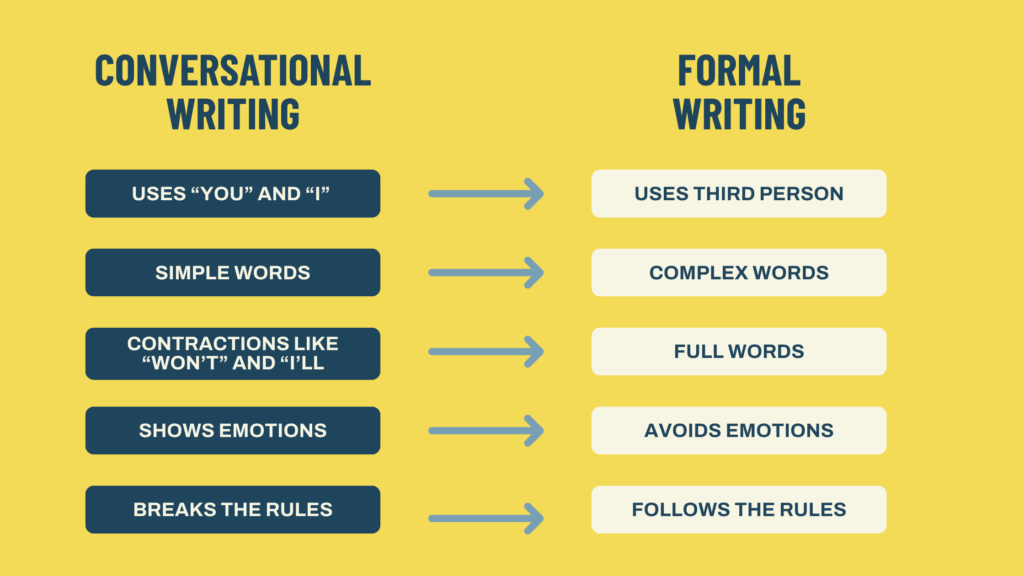Boosting engagement with your content can be as simple as writing the way you talk.
Great copywriting does more than inform or impress. It creates a moment of shared understanding between two living, breathing human beings.
Yep, that’s right: it’s dialogue, not monologue.
Whether you’re writing a blog, an email, or even a simple ol’ social caption, your words can invite people in – or hold them at arm’s length. Option A is better … always! And especially today: in an age where AI can churn out text in seconds, readers naturally retreat from stiff-sounding copy. And they have a radar for when something feels robotic or overly polished.
On the other hand, conversational writing helps you show up as authentic, approachable, and clear. It makes your content easier to read and your brand easier to trust. It’s truly a skill worth practising if you want to turn casual readers into advocates for your work.
There’s plenty of evidence that it achieves business goals, too. Neil Patel, famed marketer and co-founder of Crazy Egg, Hello Bar and KISSmetrics once ran an A/B test on two versions of the same blog post – one written in a formal tone, and the other written conversationally. The conversational post came out the clear winner:
247% more readers consumed the full article when written in a conversational tone
Readers spent an average of 4:45 minutes reading the conversational version, and only 1:22 minutes on the formal tone version
In this post, we’ll walk you through everything you need to know about how to achieve a conversational tone in your writing:
What is a conversational writing style?
The difference between conversational writing and formal writing
When you should use conversational writing
11 tips for practising conversational writing
Real examples of conversational copy
Ready? Let’s dig in.
What is a conversational writing style?
Conversational writing feels like a one-on-one conversation between your audience and you.
It’s real, meaningful, and relevant. It should create a kind of intimacy, ideally by using language and phrasing familiar to the audience. And it avoids stodgy words and sentence construction at all costs.
Let’s look at a few examples.
Here’s a fun one to start us off. Swedish oat milk company Oatly has some of the most lively, conversational copy we’ve seen in a brand – their entire online presence reads like a loose chat with your slightly silly European friend.
Axios, a media company that covers the energy industry, could easily resort to dry corporate prose. But they use conversational language surprisingly well to hook and engage readers off the top of their popular e-newsletter. They keep their sentences short ’n’ snappy – and never shy away from an exclamation point or emoji, either!
Many small businesses do conversational tone really well. Little Black Kat Creative, for example, is an Australian graphic design firm that produces unique, custom designs. Her website invites the audience to have some fun with her, and uses an easy-to-read conversational tone that reflects the way one would talk to a friend.
Conversational writing helps you to:
Convey your message more easily. You use simple words, not fancy ones or jargon.
Engage better with customers. You show you’re genuine and human. You write like you talk.
Build a strong brand. The more customers want to engage with you, the stronger the relationship between them and you.
Increase conversions. Relationships build trust. Once trust is established, it can skyrocket your sales
The difference between conversational tone writing and formal writing
Here are a few simple rules help to distinguish conversational writing from formal writing:

Formal writing uses longer sentences and words, complex sentence structures and language that would make your university professors proud. If you’re writing an academic paper, it’ll help you to sound smart and studious.
But out in the rest of the world, formal writing often imposes a cognitive burden on your readers. Conversational writing, on the other hand, allows you to sound, well, human. And humans tend to prefer doing business with other humans.
When you should use conversational tone in writing
The tone you adopt in your writing depends on many factors: the kind of business you’re in, your target audience, your messaging goals.
But unless you’re writing academic papers or working in law, you can likely safely use a conversational tone in almost all of the content you produce: from blog and social media posts, to email copy, web copy, landing pages, etc.
Why?
Because ultimately, with any communication piece, your goal is to convey your message clearly, memorably, and in an engaging way. You want your audience to pay attention.
By consistently using conversational writing style, you make your brand accessible and memorable. Seth Godin has been doing this for years and has built a brand that is memorable not only for its thought-provoking work, but also for its ability to engage a wide cross-section of audiences.
11 tips for practicing conversational tone writing
Unlearning the urge to write formally takes some work. We all learned supposedly “unbreakable” rules back in high school, and our English teachers’ voices still echo in our ears as we strive for verbal perfection.
But this will make your writing better, so let’s take the plunge! Follow these 11 tips to create an easy, conversational tone in your writing.
1. Choose simple words
Avoid words you’d never use in real life, like “utilize” instead of “use.” No one says “utilize.” Remember that you’re writing to connect, not to impress.
Also, avoid industry jargon as much as you can. Write so that anyone can understand what you’re talking about.
The Canadian government has a great online guide to plain language writing.

2. Use the second-person voice
Using the second-person “you”puts your reader at the forefront and makes them feel more like they’re a part of a face-to-face conversation.
As David Ogilvy, the “father of modern advertising,” once wisely said: “Don’t address your readers as though they were gathered together in a stadium. When people read your copy, they are alone. Pretend you are writing to each of them.”
3. Write short sentences
Keep your sentences short. Break long sentences into many short ones.
Why?
Because long sentences reduce readability.
A long sentence can make readers’ minds wander off mid-sentence. It takes more focus and time to process the information when a new piece of information is already vying for your attention. By shortening your sentence, you make your point easier to read and understand.
Look at Hiut Denim’s website for a great example of short sentences. The brand applies a conversational tone by using short sentences, simple words, and clear writing:
4. Use contractions
Do you say, “I will go to work,” or “I’ll go to work?”
In conversation, we use contractions. In conversational writing, we do it, too. It’s organic.
5. Avoid passive voice
In an active-voice construction, the subject of the sentence carries the action of the verb. But in the passive voice, the subject of the sentence is being acted upon by the action. It not only makes the sentence longer, but it’s also harder to understand.
Look at these examples:
Active voice: You can return your order.
Passive voice: Your order can be returned.
Which one gives customers more confidence?
The answer is obvious: the active voice.
6. Ask questions
A question makes your audience stop to think about their answers. It changes the flow of your writing and keeps your audience involved in the conversation. Wouldn’t you agree?
7. Break grammar rules
Conversational writing style gives you the freedom to break the rules. That’s useful when you want your copy to come across as friendly and approachable.
Here are some grammar rules you can break:
Never start a sentence with and or but. Starting a sentence with “and” or “but” can make your point stronger. And how can you argue with that?Never use contractions. Contractions make a piece less formal and more approachable, don’tcha know.Never end a sentence with a preposition.“That is a rule up with which I will not put.” It may be a Winston Churchill misquote, but this absurd phrasing makes an excellent point. Let your words roll out naturally rather than forcing an awkward mouthful to be grammatically correct!Never start a sentence with a conjunction. A sentence may flow better conversationally when started with a conjunction like “which” or “but.” Which is why it’s OK to break this rule.
This is a great example from Bombas, a sock company. Bombas uses casual language and short sentences (E.g. “No matter the sitch, you’re covered”). It also constantly breaks grammar rules with standalone fragments (“Pinky toe promise.”) in its Happiness Guarantee. Not grammatically “proper” at all, right? But it feels like you’re chatting with a friend.
8. Tell a story
A good story can change our attitudes, beliefs, and behaviours. It can appeal to personal emotions and create empathy. Our brains simply love stories.
Canadian e-commerce company Dbrand is known as much for its edgy, conversational brand voice as its sturdy phone cases. And they use creative, almost surrealist storytelling to turn even simple email promos into mini stories. Showing how even transactional messages can feel lively and human when you borrow the beats of story.
9. Show your personality
Let your character – or brand character – shine through.
Tell your audience why you’re on your mission to change the world
Share your journey of how you became who you are
Share behind-the-scenes details about your company
Share the mistakes you’ve made
Create your own style of using metaphors and images
When you reveal a little bit of yourself through your content, your audience will become more curious and attracted to it. They’ll want to know more about you.
And that’s where a long relationship begins.
10. Write like you’re talking to a friend
It’s a good idea to imagine you’re writing to a friend. Make your audience feel like they’re in your fold. Here’s an example from Barkbox of a fun approach and super casual tone on its website. It’s created an approachable and honest brand voice that pet lovers can relate to.
11. Read it out loud
Read your copy aloud and ask yourself if it sounds like writing. If you can write the way you talk, it’ll naturally come across as conversational.
Or, try explaining what you’ve written to a friend. Then, replace your draft with what you just said to them.
“If you simply manage to write in spoken language, you’ll be ahead of 95% of writers. And it’s so easy to do: just don’t let a sentence through unless it’s the way you’d say it to a friend.”
—Paul Graham, Co-founder, Y Combinator
Your turn
Using a conversational tone in writing is a great way to engage your audience. So give it a try. Break some rules and give your readers a good reason to keep reading. Take the time to edit your copy to make it more conversational. And hopefully it will eventually lead to more actual conversations with your customers.
Want better messaging? Start with a solid foundation!
Our Foundational Brand Messaging service is the ticket! In just 2–3 weeks, we’ll help you clarify your voice, define your core messages, and lay the groundwork for content that sounds and feels like you.
Looking for guidance on how best to engage your audience? Get in touch, we’re here to support with content strategy, implementation and blueprints for good storytelling.












